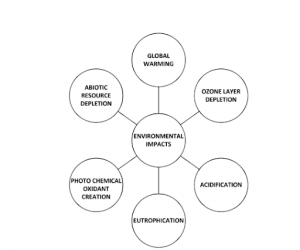Lesson 3: Enviromental impacts
In this lesson, we will explore various environmental impacts caused by human activities, emphasizing the importance of environmental protection.
- Introduction to Environmental Impacts
- In recent decades, environmental protection has become a global concern, as people recognize the serious threat of pollution and their responsibility to address it.
- Different Environmental Impacts
- Environmental impacts encompass a wide range of consequences resulting from human activities. These impacts include:
2.1. Global Warming (GW)- Defined as changes in surface-air temperature caused by the “greenhouse effect,” induced by the emission of greenhouse gases into the atmosphere.
- 2.2. Ozone Layer Depletion
- The fragile ozone shield (O3) in the stratosphere, crucial for regulating radiation balance, is damaged by complex reactions with greenhouse gases, particularly Chloro-Fluoro Carbons (CFCs).
- 2.3. Acidification
- Occurs when wet and dry atmospheric fallout with low pH combines with gases and particulate matter released from burning fossil fuels, resulting in sulphuric and nitric acid in rain, fog, snow, and gases.
- 2.4. Eutrophication (“Algal Blooms”)
- Increased nutrient levels (nitrogen/phosphorus) in water bodies lead to altered biological growth, potentially causing disruptive “algal blooms” that affect local ecosystems.
- 2.5. Photochemical Oxidant Creation or Smog (“Ozone Alarm”)
- Ground-level ozone, harmful to mammals and plants, increases and forms smog, causing various environmental problems.
- 2.6. Abiotic Resource Depletion
- The excessive consumption of non-renewable resources such as crude oil, coal, and iron, which are crucial for manufacturing and energy production.
- Environmental Impact Explanations
- Let’s delve deeper into some of these environmental impacts to better understand their causes and consequences:
3.1. Global Warming (GW) – GW leads to changes in global temperature patterns, primarily due to increased greenhouse gas emissions.
3.2. Ozone Layer Depletion – The ozone layer, vital for protecting Earth from harmful radiation, is threatened by human-made gases like CFCs.
3.3. Acidification – Acid rain and atmospheric acidity can weaken ecosystems, affecting the health of forests and trees.
3.4. Eutrophication (“Algal Blooms”) – Nutrient-rich water disrupts aquatic ecosystems, potentially causing excessive algal growth.
3.5. Photochemical Oxidant Creation or Smog – Ground-level ozone formation leads to smog, negatively impacting air quality and health.
3.6. Abiotic Resource Depletion – Excessive reliance on non-renewable resources poses long-term sustainability challenges for our society.
- Environmental Impact Mitigation
- To address these environmental impacts, it’s essential to reduce emissions, adopt sustainable practices, and develop alternative resources and technologies.
Conclusion
- Understanding the diverse environmental impacts resulting from human actions is vital in our quest to protect our planet.
- Environmental protection and sustainability efforts are essential to mitigate these impacts and ensure a healthier future for our planet.
In this lesson, we’ve explored various environmental impacts and their implications. Understanding these impacts is the first step towards adopting sustainable practices and protecting our environment.
